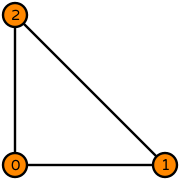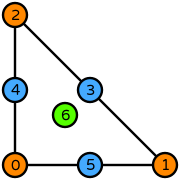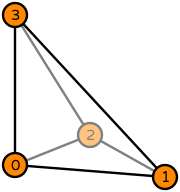Click here to read what the information on this page means.
| FIAT | FIAT.KongMulderVeldhuizen
↓ Show FIAT examples ↓↑ Hide FIAT examples ↑Before trying this example, you must install FIAT: pip3 install git+https://github.com/firedrakeproject/fiat.git This element can then be created with the following lines of Python: import FIAT
# Create Kong-Mulder-Veldhuizen order 1
element = FIAT.KongMulderVeldhuizen(FIAT.ufc_cell("triangle"), 1)
# Create Kong-Mulder-Veldhuizen order 3
element = FIAT.KongMulderVeldhuizen(FIAT.ufc_cell("triangle"), 3)
# Create Kong-Mulder-Veldhuizen order 1
element = FIAT.KongMulderVeldhuizen(FIAT.ufc_cell("tetrahedron"), 1) |
| Symfem | "KMV"
↓ Show Symfem examples ↓↑ Hide Symfem examples ↑Before trying this example, you must install Symfem: pip3 install symfem This element can then be created with the following lines of Python: import symfem
# Create Kong-Mulder-Veldhuizen order 1 on a triangle
element = symfem.create_element("triangle", "KMV", 1)
# Create Kong-Mulder-Veldhuizen order 3 on a triangle
element = symfem.create_element("triangle", "KMV", 3)
# Create Kong-Mulder-Veldhuizen order 1 on a tetrahedron
element = symfem.create_element("tetrahedron", "KMV", 1) |
| (legacy) UFL | "KMV"
↓ Show (legacy) UFL examples ↓↑ Hide (legacy) UFL examples ↑Before trying this example, you must install (legacy) UFL: pip3 install setuptools
pip3 install fenics-ufl-legacy
This element can then be created with the following lines of Python: import ufl_legacy
# Create Kong-Mulder-Veldhuizen order 1 on a triangle
element = ufl_legacy.FiniteElement("KMV", "triangle", 1)
# Create Kong-Mulder-Veldhuizen order 3 on a triangle
element = ufl_legacy.FiniteElement("KMV", "triangle", 3)
# Create Kong-Mulder-Veldhuizen order 1 on a tetrahedron
element = ufl_legacy.FiniteElement("KMV", "tetrahedron", 1) |
- Chin-Joe-Kong, M. J. S., Mulder, Wim A., and Van Veldhuizen, M. Higher-order triangular and tetrahedral finite elements with mass lumping for solving the wave equation, Journal of Engineering Mathematics 35, 405–426, 1999. [DOI: 10.1023/A:1004420829610] [BibTeX]
| Element added | 09 May 2021 |
| Element last updated | 16 September 2023 |


